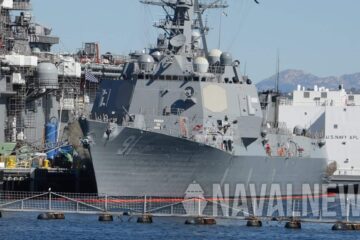The future USS Jack H. Lucas will be the 75th Arleigh Burke (DDG 51) class destroyer, and the first of the DDG 51 Flight III ships.
NAVSEA press release
Builder’s trials consist of a series of in-port and at-sea demonstrations that allow the shipbuilder to assess the ship’s systems. For DDG 125, these trials also mark the first opportunity to test the new Flight III systems while underway. The trials are conducted by the shipbuilder, Huntington Ingalls Industries’ (HII) Ingalls Shipbuilding division in Pascagoula, Mississippi.
“Embarking on Builder’s Sea Trials is a significant accomplishment for the DDG 51 program. As the first Flight III ship, DDG 125 is the culmination of years of dedication and perseverance to design, build, and integrate the Flight III capability of BL 10, AMDR and the supporting systems such as the new Electric Plant and associated upgrade to the Machinery Control System.”
Capt. Seth Miller, DDG 51 class program manager, Program Executive Office (PEO) Ships.
The future USS Jack H. Lucas will be the 75th Arleigh Burke (DDG 51) class destroyer, and the first of the DDG 51 Flight III ships. The Flight III upgrade is centered on the AN/SPY-6(V)1 Air and Missile Defense Radar and incorporates upgrades to the electrical power and cooling capacity. Flight III is the fourth Flight upgrade in the proud history of the class, and the largest upgrade to date.
The DDG 51 Arleigh Burke-class Guided Missile Destroyer (DDG 51) is a multi-mission guided missile destroyer able to operate offensively and defensively, independently, or as units of Carrier Strike Groups, Expeditionary Strike Groups, and Surface Action Groups. These ships respond to the full range of military operations including Low Intensity Conflict/Coastal and Littoral Offshore Warfare scenarios and open ocean conflict, providing or augmenting power projection. Flight III ships will fill the critical need for enhanced surface combatant Integrated Air and Missile Defense.
HII’s Ingalls Shipbuilding division is also under construction on the future Ted Stevens (DDG 128), Jeremiah Denton (DDG 129), George M. Neal (DDG 131) and Sam Nunn (DDG 133).
-End-
Update – Raytheon reached out to Naval News with the following statement:
“After several years of testing its remarkable capabilities with land-based arrays, it is thrilling to see SPY-6 radar operating at sea for the first time. The radar is operating as expected, and has demonstrated some tactical operations and tracked objects like satellites and air targets of opportunity. The success of these initial trials is a result of teamwork with our partners in the Navy and at HII Shipbuilding who have worked extremely hard and found innovative ways to keep Jack on Track.” -Mike Mills, SPY-6 Program Director, Raytheon Missiles & Defense
Naval News comments: About DDG 51 Flight III Destroyer

Flight III destroyers will have improved capability and capacity to perform Anti-Air Warfare and Ballistic Missile Defense in support of the Integrated Air and Missile Defense mission. This system delivers quick reaction time, high firepower, and increased electronic countermeasures capability for Anti-Air Warfare.
The Flight III design contains modifications from the earlier DDG 51 class, to enable the SPY-6 radar, in association with Aegis Baseline 10, which includes larger electronically scanned arrays and the power generation and cooling equipment required to operate the powerful new radar.






